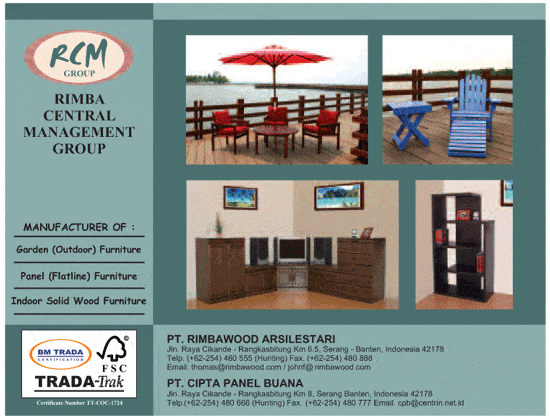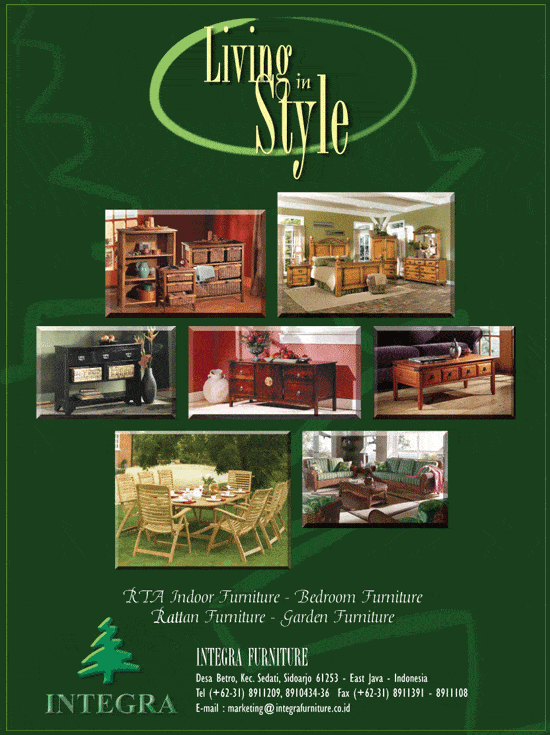Text and Research by: Frederic Niko Voutsinas. Project Coordination: Mary Luna Matuk. Visit us at www.focusreports.net. For more information contact: info@focusreports.net.
Indonesia’s unique culture and furniture capabilities today are rooted in the country’s history as an outpost of Malay, Chinese, Indian, Arab, and Dutch explorers, colonists and traders and their lasting religious influences coming from Buddhism, Hinduism, Islam and Christianity. Several Javanese villages perpetuate their legacy of hundreds of years of wood craftsmanship. Surabaya is known for garden furniture, Jepara is famous for hand-crafted designs, and 60,000 specialized workers in Cirebon, West Java, craft furniture only of rattan.
The world’s largest archipelago is one of the major furniture exporting countries with 2004 exports in excess of $1.5 billion (75% from wooden furniture and more than 20% from rattan furniture). Indonesia has been a Top 10 exporter to the USA with consistency since 1995. One-third of Indonesian furniture exports end up in America. Mr. Sea Tanangga, Executive Director of ASMINDO (Indonesia Furniture Industry and Handicraft Association), the leading voice of the furniture industry with over 800 member companies, expects 20% growth in furniture exports, reaching $1.8 billion by 2010.

But the industry is under pressure from several directions. Since the 1997/98 Asian Economic Crisis, access to financing has been difficult, some highly sought after raw materials have been scarce, and short-sited traders generate half of the country’s furniture exports. Many feel that there is a lack of design talent and marketing expertise in the local economy, and there is no coordinated Master Plan for the industry. Especially in the face of stiff new competition from China, there is a need to redefine what it means for a piece of furniture to be “Made In Indonesia.”
Mr. Prieyo Pratomo, Design Consultation Manager at Indonesia Design Center (IDC), an NGO whose membership includes all of Indonesia’s design-oriented associations, believes that the small and medium-sized companies that make up most of the sector are not living up to their potential. He laments that they don’t fully understand the benefit of investing in value-added design. To him, the key to successfully redefining what it means to be “Made in Indonesia” is to fuse the ‘warm design’ that captures the country’s rich tradition of craftsmanship and diverse natural resources with modern trends.
A key to incorporating warm design into Indonesian furniture is to adapt raw materials that best protect Indonesia’s ecology while maintaining high quality standards and competitive cost. Tanangga of ASMINDO agrees: “Our most successful companies are incorporating more eco-friendly materials into their goods.” Plantations are now planting fast-growing trees like white teak, eucalyptus, nyatoh, mango, albasia and acacia. These emerging species have started to show high levels of acceptance in international markets.
A firm commitment to incorporating new species has become increasingly critical to the success of local companies since the government recently started to allow the export of many raw materials. Mr. Tanangga of ASMINDO, criticizes this decision: “allowing Sumatra, Sulawesi and Kalimantan rattan – 80% of the world’s supply - to be sold to foreign competitors is tantamount to giving away our competitive advantage. First, the value of raw material exports is small compared to value-added furniture exports, and second, employment is a critical issue in Indonesia, and many of the one million furniture-related jobs here are at risk.”
Indonesia has been blessed by Mother Nature with the fertile soil that is home to the world’s third largest tropical forest and more plantations than any other country in Asia. As the world's largest exporter of tropical timbers, generating upwards of US$5 billion annually, many buyers see the archipelago as their one-stop-shop. But this commercial success has not come without consequence as the country has been singled out in the past by NGOs for massive deforestation. Recent governments have worked hard to put an end to illegal logging and clear cutting. As a result, while tropical forest coverage fell to an all-time low of 53% in 1995, it has rebounded amazingly to over 60% today.
In the past, illegal logs were exported without paying duties. This caused the government to lose revenue and hurt local furniture producers who ended up paying more for domestic raw materials than their regional competitors. Not only does the industry have to be on alert for foreign competitors who aim to poach natural resources, they also have to keep a close watch on their human resources as Indonesian furniture workers are being hired away by foreign companies! Mr. Ch’ng Keok Chai, Director of Yeh Brothers Wood Works, a Malaysian manufacturer that produces components in a state-of-the-art Indonesian facility, explains this by the fact that “the labor in Indonesia is cheaper than in most of industrialized China and the workers are more skilled and harder working than their counterparts in Malaysia.”
Another challenge the industry faces, if it wants to retain its international stature, is to assure standardized quality and take a long-term business view. Introduction of these types of concepts can be difficult, particularly within the context of an industry broadly organized around small companies. But this structure, according to Mrs. Yanti Rukmana, Director of Yudhistira Furniture, could be turned into an advantage. She explains: “While it may be difficult for many Indonesian mass manufacturers to compete on price, foreign producers cannot compete with our unique ethnic designs and long-standing tradition of craftsmanship. We have to work harder and differentiate our product offerings by highlighting our core competencies such as producing unique hand-made pieces. Another advantage we have against the Chinese is that, while they often limit a container to a maximum of five different items, we can show greater flexibility in combining more than 20 items into a container order. Our approach is especially suitable to retail shops that find that they can buy exactly what they want in Indonesia.”
Lean and mean: Indonesia’s next generation of savvy furniture specialists
There are a handful of highly successful manufacturers who have created massive success in North America by blending warm design and smart sourcing with advanced technology and progressive management techniques.
The typical path to success for Indonesia’s leading furniture companies has started with humble beginnings and culminated with big accounts abroad. Integra Furniture got their international start in the early 1990s with a production contract for a simple CD rack from IKEA. Mr. Halim Rusli, Director of the family-operated East Java business, explains: “We benefited from that experience by incorporating best practices in production and management and establishing a track record of excellence that allowed us to gain partnerships with high-profile US names like Palliser, Lexington, Pottery Barn, Home Depot and Sears.”
Along the way, Integra invested heavily in the latest technologies and pushed their expertise in designing a wide variety of middle to high-end traditional and contemporary pieces. Rusli is very proud of Integra’s finishes: “Since Lexington sells their pieces to galleries, we use a premium 12-step finish, nicer hardware, and pay special attention to flawless cosmetics and detail. While production specifications for our middle-grade pieces may require only 6 or 7 step finishing, they still feature the same solid structural foundation.”
While Integra currently ships 350-450 containers of indoor and outdoor collections to the USA each month, capacity should ramp up to accommodate 600 – 700 monthly containers once a new facility is completed within one year. Growth opportunities abound, particularly in the dining and kitchen segments, but managing growth responsibly is fundamental to Integra’s future. With a staff of over 6,000, a lot of planning has to go into ensuring that growth in human resources is accompanied by parallel growth in product quality.
In-house woodworking teachers join forces with external management consultants to provide new workers the necessary practical knowledge of wood working. At the same time, a permanent Capacity Development Team of problem solvers visits foreign factories recommended by consultants in order to identify potential improvements.

Also, Integra’s hands-on approach to R & D - in which they create new design concepts for collections - contributes greatly to the long-term satisfaction of their partners. “We invite experts from all our customers to guide our 35-person R & D team on different cosmetic techniques because we embrace continuous improvement. Enlisting external consultation is central to Integra’s business model”, explains Mr. Rusli, “since our attitude is that we can never allow ourselves to feel that we are the smartest company or the best leaders.”
Mr. Rudi Halim, Chairman of Serang Banten-based Rimba Central Management Group (RCM), also sees a clear trend among the very best performing Indonesian furniture producers to enlist the talents of the most reputable consultants around. He explains, “foreign technicians train the RCM workers who operate the very sophisticated high-speed cutting machines and automated finishing lines which we have recently deployed.”

Acknowledging that Indonesian companies may not be able to compete against Malaysian competitors in market segments that require high levels of design, RCM proactively invests in new technologies that create long-term capabilities and efficiencies. Halim asserts: “Our buyers rate us as one of the best set up factories in the entire region.”
Such mastery of manufacturing processes has enabled RCM to become one of the few players in Indonesia to be involved in both panel and solid wood production. Efficient production also allows the company to enter new market segments at the low end before methodically working up the value chain. Today, RCM has found huge demand for their high value-added solid wood garden furniture in Europe, USA, Japan and Australia. A new line of value-priced RCM veneer living room sets and home offices is due to hit the US by storm in the near future.
Both Integra and RCM prove that while the Indonesian furniture industry may lack total-package solutions, some players have found the right balance of materials, manpower, technology, design, and business practices to become highly attractive partners for the most demanding international buyers.

